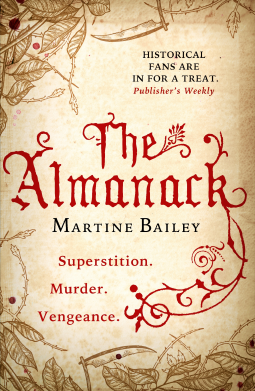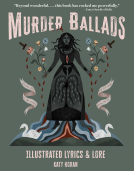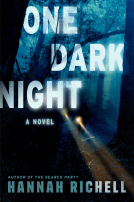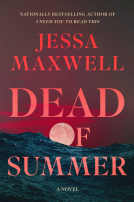
The Almanack
by Martine Bailey
This title was previously available on NetGalley and is now archived.
Send NetGalley books directly to your Kindle or Kindle app
1
To read on a Kindle or Kindle app, please add kindle@netgalley.com as an approved email address to receive files in your Amazon account. Click here for step-by-step instructions.
2
Also find your Kindle email address within your Amazon account, and enter it here.
Pub Date Mar 03 2020 | Archive Date Nov 30 2019
Talking about this book? Use #TheAlmanack #NetGalley. More hashtag tips!
Description
"Puzzle solvers and historians will love this mystery" Booklist
Superstition. Murder. Vengeance.
Tabitha Hart earns a scandalous living in London, with whichever gentleman has enough coin for her company. But in the summer of 1752, her mother urgently summons her home to the village of Netherlea and, with reluctance, she returns. However, she is greeted by the news that her mother has died in disturbing circumstances.
Finding cryptic notes in her mother’s almanack, Tabitha is determined to discover the truth, but the superstitious villagers are wary of her. Only the enigmatic Nat Starling is prepared to join her, as she sets out to uncover her mother’s killer. But soon the summer draws to a close and snow sets in, cutting off Netherlea from the outside world. As an unknown killer prophesies their deaths, Tabitha and Nat now face the darkest hours of their lives.
Advance Praise
'Bailey's prose sparkles'
The Times
'A dark and twisting riddle that is certain to keep readers guessing until the end'
S D Sykes
'An ingeniously plotted, hauntingly atmospheric murder mystery'
Deborah Swift
'A beguiling historical novel set in the Georgian era. Witty, wily, and great fun'
Essie Fox
'Puzzle solvers and historians will love this mystery, and Bailey's richly detailed story is perfect for fans of Ariana Franklin and Rhys Bowen'
Booklist
'A beautifully constructed, deeply satisfying read that plays with the reader, demanding that you keep your eyes on the shadows as much as on the main stage. And it has riddles . . . 50 of them to read with the story or save for a treat'
Historia Magazine
'Historical fans are in for a treat'
Publishers Weekly
'As clever and beautiful as a tapestry'
Rebecca Mascull
'Murderously dark and delightful'
Melissa Bailey
Available Editions
| EDITION | Other Format |
| ISBN | 9781838850357 |
| PRICE | $14.00 (USD) |
Featured Reviews
Murder, mystery, riddles and puzzles. A great story with lots of twists. The historical setting is very well done and I really enjoyed the insight into almanacs. The main characters slowly reveal their better qualities as initial suspicions are put aside. Tension is maintained right through to the final chapter and there is plenty to keep the reader guessing.
A thoroughly enjoyable read that insight recommended.
 Sarah B, Reviewer
Sarah B, Reviewer
This book was a delight from start to finish, weaving folklore, romance, family tensions and murder alongside descriptions of bucolic splendour and also the harsh realities of village life in the mid 18th century. It is a well researched book and preceding each chapter was an authentic riddle (with answers at the back of the book) that linked to the contents of the chapter and I really enjoyed trying to solve the little mysteries. The characters were all brought to life in the most evocative way, even those that were primarily to move the plot along , and I could practically see the village of Netherlea and all its inhabitants in front of me as I read further on. The writing flows at a good pace and the clever tying up of all the loose threads reminded me a little of Dickens crossed with Hardy, but brought bang up to date.
My thanks go to the publishers and Net Galley for the advanced copy in return for an honest review.
 Hannelore C, Reviewer
Hannelore C, Reviewer
Thank you NetGalley and Black Thorn for the eARC.
An impressive read with a good story, a terrific sense of place and lots of interesting facts about life in 1752 in rural England. I was also fascinated by the fact that Almanac(k)s were so enormously popular...I didn't realize almanacs were around in those days.
Tabitha Hart, after a heartfelt request by her mother, reluctantly leaves her beloved life in London for Netherlea, the village she grew up in.
Unfortunately her mum is already dead (drowned) and she's surrounded by antagonistic villagers, with her young child to look after (a task she doesn't relish) while being broke. She's suspicious about her mum's death and determined to find the killer.
I hate to admit that I wasn't particularly good at solving the riddles at the start of every chapter, a good thing the answers are at the end of the book!
A clever mystery (kudos to the author) which I recommend highly.
 Fran E, Reviewer
Fran E, Reviewer
In the year 1752, at a London inn, a gentleman sent a bottle of claret to the table of 19 year old Tabitha Hart. "You are seeking business tonight, lady?" "Tabitha remembered her own sorry plans to strip the fellow of his purse and abandon him at first light. If only she had woken first... The villain has taken every farthing I own and my box and clothes besides..." She is forced to forego a carriage and must walk home to Netherlea.
"Netherlea was a village of countrified clods, gossips and whisperers...In London she had kept her past tucked away...now, with a sense of dread...she took the soiled memories out once more." Entirely penniless, dressed in her underclothes, she arrived at her squat, wattle-and-daub cottage. Her mother, Widow Hart, had written to Tabitha requesting that she make haste and return home. Tabitha is devastated upon discovering that she is too late, her mother has died. Although the cause of death was deemed the drowning of a woman whose "...mind was disordered...went wandering at night...", Tabitha was convinced otherwise. Her mother's head wound suggested foul play. She was bound and determined to seek justice for her mother...but how?
A thorough search of the cottage unearthed Widow Hart's Almanack replete with cryptic notes documenting her daily ruminations. Tabitha found a tiny cross crafted from rowan twigs, "a protection against evil". "The rowan cross confirmed the truth her mother had been terrified...[Tabitha] uncovered a newly inked [writing]".
"A Riddle for Mistress Hart"
I see you as you watch and spy,
Consumed with curiosity;
A maggot feeding on the dead,
And feasting on calamity.
Don't think you'll end my sovereign power-
'Tis you whom worms will soon devour.
Signed "D"
Who is the mysterious "D"? The plot thickens as another Netherlea resident falls victim. The Almanack predicts a "violent, bloody end" to 1752. Will more deaths follow? By trying to unmask "D", was Tabitha's life now in jeopardy?
"The Almanack" by Martine Bailey was a multi-layered who-dun-it which takes place during the year of 1752, at a time when England adopted the Gregorian calendar, a year with eleven less days. The populace was arguably "off-balance" as a consequence of this loss of time. The eighteenth century was the "golden age of enigmatography". Author Bailey effectively used riddles to "give an insight" into the Georgian era, a time when word puzzles were often printed in almanacs and magazines. Many well fleshed- out characters are introduced in this novel...a writer, doctor and rent collector, to name a few. This period piece masterfully evoked the narrow mindedness and small village mentality of 18th Century England. A well researched, captivating read.
Thank you Black Thorn Books and Net Galley for the opportunity to read and review "The Almanack".
It is 1752 and Britain is on the verge of moving from the Gregorian to the Julian calendar. After an urgent message from her mother, Tabitha returns to the village of her birth where tragedy awaits. There she meets Nat, an aspiring writer, and they find themselves at the mercy of and in the hunt for a mysterious killer..
The language and setting seem authentic to these uneducated eyes and the plot develops at a steady pace. The identity of the killer is witheld until late on but is rather heavily signalled from much earlier. Nevertheless, the climax is satisfying although somewhat predictable.
Each chapter begins with a riddle, some easier than others to interpret, which gives title to the events of that chapter. This is followed by an extract from an almanac relating to the date of the events in that chapter. These are interesting additions to the enjoyment of the story although I must confess that the significance of the almanac to the killer and his actions was difficult to ascertain.
An enjoyable read and an author to look out for in the future.
The Almanack, by Martine Bailey is a mystery, amateur sleuth delight that is an all around good read.
The Almanack, by Martine Bailey follows the main character, Tabitha Hart, and the secondary main character, Nat Starling. Tabitha, having left her small village to have a scandalous life in London, is called back home to Netherlea by her mother via a letter in which she appears to be worried about something. Concerned, Tabitha rushes back home, with some misfortune on the way, only to arrive too late as her mother had died before her arrival.
After finding out about her mother, Tabitha soon realises that there was more to her death than meets the eye as she finds a threatening note from, and references in her mothers almanac to, a mysterious person named 'D'. After this convinces Tabitha that there are more sinister motives at play she begins to try and unravel the truth, but as more murders occur and the threat grows closer to her, it seems this will not be as easy as she first thought.
After, Tabitha begins her search for 'D' she meets Nat, a man who knows her by her London reputation, who is hiding some secrets of his own. As Nat attempts to uncover his own truths, he also ends up tangled in the sinister happenings of Netherlea. Initially suspicious of Nat, but unable to deny their connection, the two end up working together in order to find and stop 'D' before the year ends in a bloody and violent way.
The question occurs. Who is 'D' and can they stop them before it is too late?
The Almanack was a very interesting book, starting with the structure. Each chapter starts off with a riddle (which you are free to try and work out, and the answers were at the end too!) and the Almanac predictions and the astrology of that day (i.e the prominence or movement of the planets.) If, like me, you love riddles then you will love this book and its structure. Not only are there riddles at the start off each chapter but the mysterious 'D' also uses riddles to tease the main characters, and predict the terrible events through the Almanac. I thoroughly enjoyed this little element of inclusion for the reader and felt it added to the story.
Furthermore, the narrative choice worked very well for this novel. Reading from both Tabitha and Nat's perspective creates more intrigue and suspense throughout the novel. This is because it allows us to get a look into their minds and so we could see when there was more to something that had happened- this also made me suspicious of Nat a few times while I was reading this! I was constantly conflicted between him being entirely innocent but also had the feeling he could be part of the sinister happenings as he had a lot of secrets himself. Furthermore, seeing things from Tabitha's perspective means you also begin to realise that there is more to her story as well, and it makes it harder for you to work out who 'D' is because you too are only accessing the information that Tabitha can. The structure and narrative of The Almanack worked incredibly well and kept me guessing all the way through the novel.
The plot of The Almanack was also fun and interesting. While it is a classic plot with an anonymous tormentor known only by an alias teases and tortures the main characters, the astrological elements, and the use of the Almanac, kept the story fresh and original. Moreover, the use of riddles that tied into the astrology and event of the chapter also created a unique dimension to the novel. The plot was filled with twists and turns that kept me guessing and the identity of 'D' completely shocked me, I was so mad that I did not guess this! But that was part of the fun and made the ending more interesting. Every twist in this novel was intricately created and made sense by the end and the novel ended in a nice, tied up way that, for this type of novel, made sense and was incredibly satisfying and sweet.
The characters that Martine Bailey created were well crafted and well developed. Now, full disclosure, I really did not like Tabitha much at the start of the novel as she came across as a trouble maker without the redeeming or slight adorable qualities. But, this did not make me dislike the novel, in fact I was kind of intrigue to see if she really was this troublesome character. As the novel went on I grew warmer to her and began to admire her headstrong and independent qualities. Tabitha is, by the end, a clever character who is wholly independent and determined, though still flawed thus, she was a character you could connect with more and more as the novel went on. Moreover, she appears to be much kinder and selfless than she originally appears while still maintaining her independence and fierce behaviour.
Nat. Now Nat is a character who messed with my emotions because I hated him, loved him, suspected him, and then wanted to defend him. I was so conflicted! So, Nat is an aspiring writer/poet. Now, I did not really enjoy the 'insta-love' connection between him and Tabitha but I did like watching their relationship develop. Despite the 'insta-love' they do not actually give into it immediately- which I really liked. Instead their relationship develops naturally before the romance becomes more prominent, this was fun to read about and was interesting as there were many twists and turns throughout their relationship. Nat was an interesting character who was also quite determined but also kind. He too is flawed, so is easier to connect with, and make stupid mistakes throughout the novel that keeps you guessing about this character but also makes you more intrigued about him and how he deals with these mistakes. Nat is contrasted with many other characters in the book, and it makes him more interesting and clearly different from most other characters.
The other characters such as the De Vallory's, Zusanna, Bess, Jennet, Joshua, the Doctor, Dilks, and Darius (etc...) were also well developed and fun to read about, with each being incredibly individual and different from each other.
The attitudes and themes explored throughout The Almanack were cleverly weaved throughout the story from social expectations, to gender, to human nature and ambition.
The Almanack, by Martine Bailey is the perfect murder mystery for people who love a historical setting, and the complex fun of working out who is behind the crimes. If you dislike gruesome and bloody murder mysteries then this is for you, though there are murders the book itself is not overly gruesome or graphic and focuses more on the mystery and the riddles.
Overall, I thoroughly enjoyed this novel and throughout it was an all around good read with the fun of a mystery!
*I received an eARC of The Almanack by Martine Bailey from #Netgalley and Black Thorn (publisher) @blackthornbks in exchange for an honest review*
posted on Goodreads (linked) and my Blog (linked) with links via my twitter @BookreviewsKb
 Katie M, Reviewer
Katie M, Reviewer
Thank you Netgally & Black Thorn Books for the advance copy of this book.
"The Almanack" is set in the year 1752 when the Gregorian calendar is being embraced by England. For the residents of Netherlea this change in the calendar and murder are causing tensions in the small village. In the middle of it all is Tabitha Hart. After being stripped of her belongings by a villain she must walk to the village of Netherlea after receiving a letter from her mother requesting Tabitha to come home. But she arrives to her mother dead.
Like her mother she has assumed the role as village searcher reluctantly. But soon she realizes her mother was murdered and other deaths follow...
Filled with riddles of the Enigmatography era. The riddles give insight to every chapter in the story. Beautifully written, multi-layered and absolutely captivated me as a reader. I thoroughly enjoyed the book and will recommend it to others.
Lovers of historical fiction thrillers w.ill thoroughly enjoy The Almanack. The riddles that are woven into the plot, and at the start of each chapter, work to keep you guessing and keep the plot moving at a steady pace.
Thank you to NetGalley for my copy of this book in exchange for my honest review.
 Catherine B, Reviewer
Catherine B, Reviewer
I received a free review copy from the publisher in exchange for my honest unedited feedback.
The Almanack is set in England during the 1750s. London is full of fun and frolics, but Tabitha Hart is summoned home by a cryptic message from her mother. Arriving in the sleepy village of Netherlea, Tabitha finds her mother has died and is determined to find out just how and why.
Bailey skillfully weaves romance, impeccable historical details and a who-done-it plot to create The Almanack. Settings are beautifully described and you get a real sense of being there with the characters. The characters themselves are well developed and the plot twists and turns to keep you guessing right to the end.
Bailey explores themes of time - the novel takes place in the year the Gregorian calender is introduced in England. Days are lost but knowledge is gained, by reading Tabitha's mothers Almanack. Riddles exaccebate the sense of mystery - character and reader alike are kept guessing throughout.
I thoroughly enjoyed the book. It's a very easy read and a little cheesy at times - perfect for a holiday book choice.
 Jenny W, Reviewer
Jenny W, Reviewer
I think the first thing to really say about this book concerns the writing style - every chapter starts with information that includes an almanac prediction of what will happen that day. There is also a riddle. Both these things set the tone for the whole book for me.... it's very atmospheric, gothic almost, where nothing is at it seems. It's set in England in the village of Netherlea in the mid 18th century and the historical setting is created well - times are hard, life is hard... so, what's it about??
We start with Tabitha Hart who has fallen victim to a robbery after her intention to take advantage of the man she spent the night with goes wrong. She's travelling back to Netherlea at the request of her mother but when she arrives her mother is dead, apparently drowned. Tabitha is immediately suspicious but the men of Netherlea are very hostile towards her and want her out of the village. Having no money and her own small child to care for, Tabitha is given permission to stay for a short while to earn her keep. What unfolds is a murder mystery - who is the mysterious D and will he kill again?
I enjoyed this book - but it falls into the 'liked' rather than 'loved' category. This author has clearly done a lot of research. I felt immersed in the world she created. But the story takes a lot of twists and turns - time in Netherlea and London and two stands develop - the mystery and a love story. I'm not sure whether the love story part diluted the impact of the mystery. I didn't really connect the with the story between Tabitha and her beau, I just didn't feel it.... I don't know whether this might have been because any sense of love and warmth didn't really fit with the otherwise dark and cold atmosphere that seemed to dominate throughout the rest of the book.
This is a good, interesting read. I think the information about almanacs might have been better at the start as opposed to the end.
I got an ARC of this book via Netgalley in exchange for an honest review.
 Debra B, Reviewer
Debra B, Reviewer
Really enjoyed this historical murder mystery set in the 18th century. It rattles along nicely, keeps you guessing and has riddles and puzzles galore along the way. The idea of basing a book around an old style almanack is a nice hook, and I loved Tabitha the feisty protagonist.
I enjoyed this book a lot. The inclusion of riddles was both relevant to the story and loads of fun, since the solution to each riddle hinted at what that chapter would reveal (and some were fairly challenging!). I also think the almanac entries for the date each chapter falls on was very clever. The style of writing is thoughtful and intelligent.
Bailey’s descriptions of people and places are detailed, but not obnoxiously so. She gives just enough to allow one to visualize clearly her characters and settings.
The mystery was well crafted, and the characters were fleshed out. I found that I really liked Tabitha and Nat, and that I wanted things to turn out well for both of them.
But the best part? I didn’t peg the villain until they did. That almost never happens – I’m usually mentally berating the characters for their thick-headedness, but not so here. Many people seem like they could be behind the crimes, and indeed, many are less than innocent – they are simply innocent of the crimes upon which this story hinges.
I like a mystery that doesn’t assume I’m thick-headed, and this one delivers. There is a lot to occupy the mind within these pages, so you certainly won’t find yourself growing bored.
The Almanack is full of intrigue and cleverness, but most importantly, it has heart. It is loads of fun to try to root out the villain in real time.
If you like historical fiction, mysteries, and/or historical mysteries, this is a good one. I liked it enough that I may even read it again, and in a world with so many books I haven’t read yet, that feels like mighty high praise.
 Bookseller 546502
Bookseller 546502
What a great read!
I adore historical fiction and this one did not disappoint.
Mystery, crime, this book has it all.
Really loved it.
 Rod M, Reviewer
Rod M, Reviewer
What an enjoyable read.
The research required to bring this book to life had to be extensive. It is always a joy for me to open a book and step into another place and time. This book delivered. The shorter chapters and riddles at the beginning of each chapter only add to the delight of reading and give clues to the mystery.
Being overly critical, there was a section of the book where Tabitha and Nat are ruminating on the future that seemed odd to me and didn't really add to the story.
There were several interesting twists to the book and they were all fun to discover. It delivers on being an entertaining, puzzle filled book but will probably fail to be very memorable after you read the final page.
SPOILER ALERT: STOP READING HERE AND ENJOY THE MYSTERY!
I would have liked something besides the typical Disney-like fairy tale ending of good prevailing over evil and the heroine living happily ever after but that could be just my taste and longing for something different.
 Jonathan B, Reviewer
Jonathan B, Reviewer
Thanks to Black Thorn Books for a review copy.
Set in 1752 ‘The Almanack’ tells the story of Tabitha, a country girl from the (fictional) village of Netherlea in Cheshire who is summoned home from her somewhat immoral but enjoyable life in London by her mother. She arrives too late and finds her mother dead but after stumbling across her mother’s treasured almanac she becomes suspicious that her death was not accidental and that Netherlea is not the peaceful and safe home that she remembers.
Almanacs were hugely in fashion at the time this novel is set, they contained astronomical information as well as predictions for events to come and puzzles for the reader. Each chapter of this book begins with a riddle and the astronomical and astrological information for the day. The riddles are fairly straightforward to solve but provide a series of entertaining challenges which break up the narrative nicely. The answers are, thankfully, provided at the end of the book in case any of the conundrums prove too taxing.
Netherlea is brought to life in the novel and it is easy to picture the village with its hierarchy of occupants from the Lord of the Manor down to the serving wenches and labourers. Like any village gossip abounds and Tabitha’s return is cause for tongues to wag. She is not the only stranger, a would be poet named Nathaniel Starling has also come to live locally for reasons which he is loath to disclose and which are the subject of much speculation.
Although primarily a mystery story the book also weaves in some interesting history. 1752 was the year that Britain converted to the Gregorian Calendar and hence ‘lost’ eleven days in September. The reaction of the villagers to this and the determination of some to continue with the dates as they had always been is beautifully realised. Many of the local folk lived their lives by the sun and religious festivals, their work being governed by the changing of the seasons, and had little use for calendars, let alone being deprived of what they saw as eleven days of their lives.
The author also weaves realistic background information into the book which brings with it a sense of realism and scholarship. For example we learn how women could use their almanacs as a means of contraception as well as gaining an insight into the early days of the sensationalist press.
The central mystery is both compelling and entertaining and, although it is not too hard to identify the villain of the piece, Tabitha’s investigations are interesting and plausible. Her character grew on me as I read the book. In the initial chapters she came across as a spoilt girl who thought herself a cut above the folk whom she had left behind in her home village but she mellows and becomes a much more thoughtful and likeable person over the course of the story.
I recommend the book to those who enjoy historical mysteries set against a realistic backdrop. The riddles are an added bonus providing a little mental work out at the start of each of the fifty or so chapters. This is undoubtedly a fun way to while away a few hours whilst as the winter nights draw in and be transported back to an age that was, in many ways, not too dissimilar to our own.
 Kelly P, Reviewer
Kelly P, Reviewer
"The Almanack" is an interesting story set in 1752. I enjoyed the writing style of the author
There are lots of mysteries in this book. This is the first book that I have read by this author and I will be looking for more books by her.
Thanks to the publisher and to Net Galley for a copy of this book.
 Yvonne C, Reviewer
Yvonne C, Reviewer
This is an interesting historical novel, and gave me a good insight into life in the late eighteenth century. Tabitha is a flawed and very human heroine. I cared about what happened to her, and the story kept my interest throughout the book. I gave up reading most of the riddles, but did solve a couple: some readers may appreciate these more than I did.
 Anne M, Reviewer
Anne M, Reviewer
Oh, I do so love a good historical yarn! And Bailey’s Almanack certainly does not disappoint. From the first scene where we meet the protagonist, Tabitha Hart, I was hooked on how she would fare. A year before we meet her, she had left Netherlea, the dreary village she grew up in and headed for the bright lights of London. Her mother urged her to come back, seemingly unsettled by something. Returning to Chester, Tabitha is robbed by her night-time customer and has to return to her village destitute, a village which she left under a cloud a year ago. She is too late to find her mother alive and slowly the clues mount that her death was anything but an accident.
I loved the “almanack” structure and the (very hard) riddles in every chapter.
The restraints of convention, gossippy village residents and forbidding priests, together with superstitions and “old knowledge” make this book a very gripping read.
 Educator 484559
Educator 484559
An enjoyable book. A little different for the normal run of the mill historical murder mystery. The plot was reasonably compelling, the characters were fairly likeable and I was kept guessing for a while. The setting was nicely described too without falling into the trap of becoming tedious. It’s certainly a cut above the average and definitely worth a read.
In the year 1752 Tabitha Hart earns a living at the pleasure of whichever London gentlemen have the coin to pay for her time, but when her ailing mother calls her home to the village of Netherlea she has no choice but to reluctantly do as she is bid. Unfortunately, by the time she returns home it is too late. Despite the assurances of the village constable and the local doctor, Tabitha finds evidence in her mother’s almanack that suggests a darker truth to her death, and a mystery that threatens more darkness to come.
This was a surprisingly engrossing read, with plenty of twists and intrigue to keep any fan of historical mysteries reading. What starts off as a simple tale soon grows into a tangled narrative of murder and conspiracy, with pretty much every major character being implicated in one way or another throughout. Each chapter is preceded by a riddle such as might be found in the pages of an almanack of the time, adding to the reader’s immersion into the story that unfolds as protagonists Tabitha and Nat uncover more and more of the mystery around them. It’s a nice little touch in a wonderfully paced and written book.
While the writing is superb, the thing that stands out the most for me is the attention to detail shown by the author. Not only does Netherlea feel like a real, working village of the time, the characters themselves are rounded and three-dimensional, and this is true of even the most minor of characters. On top of this she also gives us a taste of the confusion caused by the adoption of the Gregorian calendar in Britain, and the disruption the loss of eleven days of September caused to everyday village life. It’s only a small detail, but it’s enough to give the novel a sense of reality, a more grounded feel than if it had been set in any other year.
All in all this is a superb read that keeps you on your toes with all the twists and turns it throws at you. While I’ll admit it took me a few chapters to get into the story, once it got its hooks into me I couldn’t stop reading and the final few chapters fairly raced to a breathtaking conclusion. I’d definitely recommend this to anyone who likes to sink their teeth into a juicy mystery, especially if they like their mysteries to be wrapped in historical trappings with an authentic feel. Definitely worth a solid four out of five stars.
This book was received from the Author, and Publisher, in exchange for an honest review. Opinions and thoughts expressed in this review are completely my own
Thanks to Black Thorn Books for a review copy.
The Almanack, is set in England during the 1750s. London is full vice and over indulgences. From the moment Tabitha wakes at an inn on her journey to Netherlea, finding that she has been robbed by her companion for the night, left with nothing other than the underclothes she’s wearing and a purloined watch shaped as a silver skull. Tabitha is summoned home by a cryptic message from her mother. Arriving in the sleepy village of Netherlea, Tabitha finds her mother has died and is determined to find out just how and why. Finding cryptic notes in her mother’s almanack, Tabitha is determined to discover the truth, but the superstitious villagers are wary of her. Only the enigmatic Nat Starling is prepared to join her, as she sets out to uncover her mother’s killer.
Bailey skillfully weaves romance, meticulous historical details and a who-done-it plot to bring forth this incredible storyline. The Almanack’s setting is richly described and you get a real sense of being there with the characters. The characters themselves are well fleshed out and and the plot keeps you engaged in this twisty novel to keep you guessing right to the end.
Bailey explores themes of time, mystery the novel takes place in the year the Gregorian calender is introduced in England. Days are lost but knowledge is gained, by reading Tabitha's mothers Almanack. Captivating riddles add an extra layer in historical, murder mystery
The author has created a beguiling well constructive historical fiction, a stunning atmospheric mystery set in the mid-18th-century England. Martine Bailey book, has perfected her writing to catapult the reader to another era. Her meticulous research is evident in her luscious wonderful descriptive details.
Rich and beguiling constructive historical fiction, a stunning atmospheric mystery set in the mid-18th-century England
Martine Bailey book, has perfected her writing to transport the reader to another era. Her meticulous research is evident in her luscious descriptive details.
#TheAlmanack #NetGalley
"Superstition. Murder. Vengeance." Set in the fictional town of Netherlea in 1752, this extremely well-written historical novel will entertain and engage. The author has done meticulous research that brings the story to life with the lovely, descriptive prose and is centered around the pages of an almanack so marks each chapter with the date, the sun and moon activity and a prognostication for the day. In addition, a truly unique feature is the riddle at the beginning of each new chapter. I blame those riddles for slowing my usual reading pace as I labored tremendously to try to guess the answer and solve each before I allowed myself to get back into the narrative!
Tabitha Hart, former prostitute in London, returns to Netherlea at the behest of her mother. Along the way, she's robbed of her money and possessions and so enters the village with nothing but her sullied reputation only to find that her mother has died. Tabitha's mother had been the village searcher -- recording and tending all manner of village life from births to deaths, and Tabitha is entreated to take on that role so that she can stay in the cottage where her mother lived with the child, Bess. Tabitha does not believe that her mother's death was a natural one and as she assumes her new duties, she is determined to find out the truth. It seems there is evil at work in Netherlea and Tabitha joins forces with an aspiring writer, newcomer Nathaniel Starling, to root out the tormentor who signs his threatening notes as "D" or De Angelo. NO SPOILERS.
A mystery in a village shrouded by superstitious beliefs and folklore where power is wielded without charity and death is a common visitor. The people that reside and work in Netherlea have hard lives and rely on the benevolence of the squire and landlord, Sir John De Vallory and his family. Why are so many afflicted and who is behind the sudden demise of certain townspeople?
This is a true delight for anyone who enjoys delving into historical fiction and I found it totally absorbing. Thank you to NetGalley and Black Thorn Books for this e-book ARC to read, review and recommend.
 Tammy B, Reviewer
Tammy B, Reviewer
Well written and evocative historical mystery with an engaging and unique heroine at its center. I enjoyed learning more about almanacks, but I confess that my interest in riddles didn't extend to solving 50 of them. However, skimming through them (which is what I did after the first several) in no way diminished my enjoyment of the story.
 Maggie M, Reviewer
Maggie M, Reviewer
It is 1752, Tabitha has been enjoying the bright lights of London. She like the fine clothes & the lifestyle her 'gentlemen friends' can give her. However, finding out her Mother needs her she returns home. She intended to arrive in style, but one last liaison on her way left her with next to nothing. On arrival she is too late to talk to her mother who dies from her injuries after a brutal attack. Not long afterwards the local laird's son is also slashed to death. In an attempt to find out what happened to her & why the predictions in the Almanack her mother was so fond of seems to be particularly apt for the events in the village. Along with Ned Starling, a struggling writer, they try to solve the mystery and avoid being blamed for the events that are blighting the village.
Each chapter starts with a riddle & a page from that day's Almanack. I liked how this gave a sense of time & place to the narrative. I also liked trying to solve the riddles. Overall it was an unusual but enjoyable read. Thanks to Netgalley & the publisher for letting me read & review this book.
 Daphne S, Reviewer
Daphne S, Reviewer
Long after the story within this book fades, I shall long remember the riddles! I found this to be an absolute gem of a read. Set in Georgian England, deep in the countryside, at the change of the calendar in 1752, when we suddenly gained eleven days, and sent every institution into a confused state. The hamlets and villages were so far removed from London, that the inhabitants carried on daily life as usual, and this gentle routine and emphasis upon almanacs provide a sympathetic background to murders, carried out by an unknown De Angelo. The story is heavy with menace and foreboding, and the characters are shifty, some generous, but the majority are narrow minded and full of their own importance.
I love the quaintness of this book! Each chapter starts with a riddle, but it is not made clear if the solving will contribute any clues to the murderer. The main theme concerns the reading, or interpretation of an almanac. References are made to the Luminary- the position of the sun and stars on a daily basis, the Observation,- the planetary positions and movements, and the Prognostications- the foretelling of the future. It was almost seen as part of a religion to lead ones life according to the almanac, but today we have horoscopes, so , not too different!. My parents always had a copy of Old Moore’s Almanac in the house, and I was astonished to find that they had been in common usage for such a long time!. Getting back to the riddles, I’m ashamed that the first riddle I solved was number 25! How ridiculously happy I felt! It was a long wait before I succeeded with numbers 35,38,41 and 48!. The false clue was well delivered, the scent of Christmas, that then mentioned Laurel. I thought I was on a winner, as my name means Laurel, and there was a person of the name , but alas, that was not the answer!
I will recommend this book most enthusiastically. I have already regaled and annoyed my husband and children, in equal measures, with the riddles!. I have spent almost two weeks on this book, thanks to those riddles! I loved this book, it’s such an unusual premise and it’s so much fun!. Fully deserving of its five star rating, thank you for a most entertaining division, beats watching the television hands down.
 Leslie G, Book Trade Professional
Leslie G, Book Trade Professional
Refreshing and it seems historically accurate, I especially liked tabitha's voice. I have to admit although I enjoyed reading the entries which are set at the beginning of each chapter I didn't bother trying to work them out .. but it did not seen to effect the reading!
Arriving too later after her widowed mother's dying, she notes a blow to her head .. who did it? Why? Nat's just arrived as a local guest and writer, and the two search it out themselves .. won't give it away here, but it seems obvious when you know it. Really clever (although I missed out the riddles bit) , this is an impressive writer.
 Jann B, Reviewer
Jann B, Reviewer
Thanks to Black Thorn and Net Galley for the ARC of this book!
I began by reading the information at the end of the book, which gave me insight into how important almanacs were to daily life. I did a bit of research and learned that the English calendar riots of 1752 occurred when the British government decided to alter the calendar, skipping 11 days, in order to bring Britain into line with most of Western Europe. Switching from Julian to Gregorian meant that 11 days had to be "lost" in order to make the change. It was decided that Wednesday, September 2, 1752 would be followed by Thursday, September 14, 1752. People were suspicious at the moving of saints' days and h only days; however, historians now believe that these protests never happened, making the calendar riots the Georgian equivalent of an urban myth.
This calendar change impacts the story, which begins when Tabitha Hart returns to her home in Netherlea after receiving an urgent request from her mother. Sadly, her return is too late, as her mother has died from drowning...or so it seems. Finding her mother's almanac, Tabitha realizes that there are cryptic messages written throughout. While preparing her mother's body, Tabitha finds evidence that her mother was murdered.
Even though Tabitha and her past are the subject of gossip and ridicule, she is not swayed in her determination to find the truth. She ends up with a young writer named Nat Starling, who also has a questionable past, and they work together to find the truth.
The mystery was clever and the characters were well written. I especially enjoyed trying to decipher the riddle that started each chapter. Thankfully, the answers were in the back of the book. Riddles were often found in almanacs, and they served as a form of entertainment. Each riddle presented here contributed to the book. I was able to figure out some of them, but was stumped on many others. This was an interesting plot device, and I wonder if the author created these riddles or found them in almanacs. Since they added to the plot, I presume she created them.
I recommend this book to anyone who loves mystery and enjoys learning some history along the way!


















